1999 TOYOTA LAND CRUISER brake
[x] Cancel search: brakePage 93 of 202
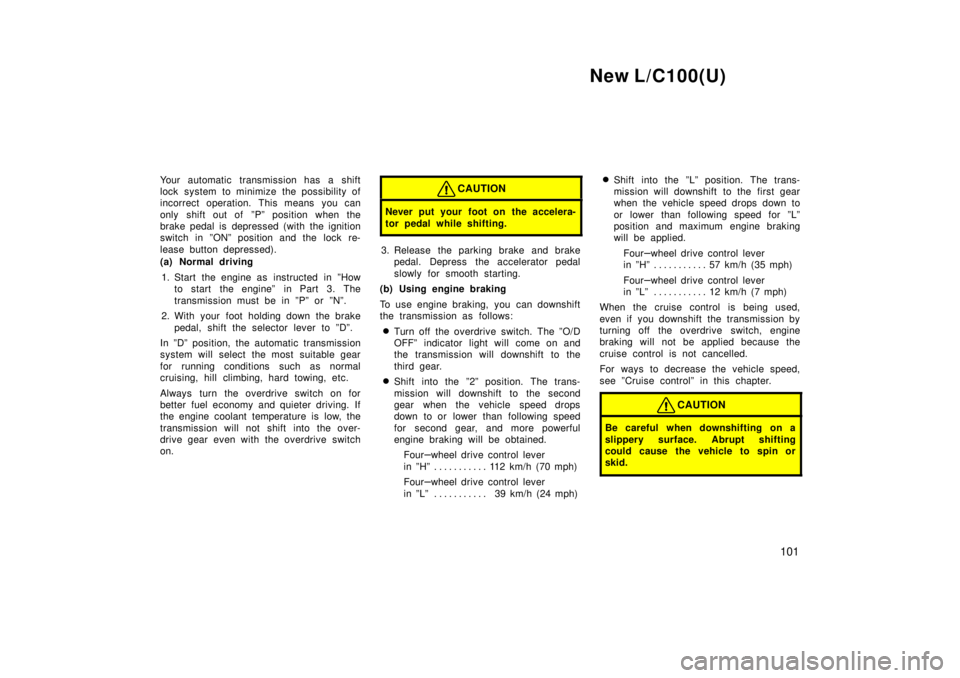
New L/C100(U)101
Your automatic transmission has a shift
lock system to minimize the possibility of
incorrect operation. This means you can
only shift out of ºPº position when the
brake pedal is depressed (with the ignition
switch in ºONº position and the lock re-
lease button depressed).
(a) Normal driving
1. Start the engine as instructed in ºHow to start the engineº in Part 3. The
transmission must be in ºPº or ºNº.
2. With your foot holding down the brake pedal, shift the selector lever to ºDº.
In ºDº position, the automatic transmission
system will select the most suitable gear
for running conditions such as normal
cruising, hill climbing, hard towing, etc.
Always turn the overdrive switch on for
better fuel economy and quieter driving. If
the engine coolant temperature is low, the
transmission will not shift into the over-
drive gear even with the overdrive switchon.
CAUTION
Never put your foot on the accelera-
tor pedal while shifting.
3. Release the parking brake and brake pedal. Depress the accelerator pedal
slowly for smooth starting.
(b) Using engine braking
To use engine braking, you can downshift
the transmission as follows:
� Turn off the overdrive switch. The ºO/D
OFFº indicator light will come on and
the transmission will downshift to the
third gear.
� Shift into the º2º position. The trans-
mission will downshift to the second
gear when the vehicle speed drops
down to or lower than following speed
for second gear, and more powerful
engine braking will be obtained.
Four ±wheel drive control lever
in ºHº 112 km/h (70 mph) . . . . . . . . . . .
Four ±wheel drive control lever
in ºLº 39 km/h (24 mph) . . . . . . . . . . . �
Shift into the ºLº position. The trans-
mission will downshift to the first gear
when the vehicle speed drops down to
or lower than following speed for ºLº
position and maximum engine braking
will be applied.
Four ±wheel drive control lever
in ºHº 57 km/h (35 mph) . . . . . . . . . . .
Four ±wheel drive control lever
in ºLº 12 km/h (7 mph) . . . . . . . . . . .
When the cruise control is being used,
even if you downshift the transmission by
turning off the overdrive switch, engine
braking will not be applied because the
cruise control is not cancelled.
For ways to decrease the vehicle speed,
see ºCruise controlº in this chapter.
CAUTION
Be careful when downshifting on a
slippery surface. Abrupt shifting
could cause the vehicle to spin or
skid.
Page 94 of 202
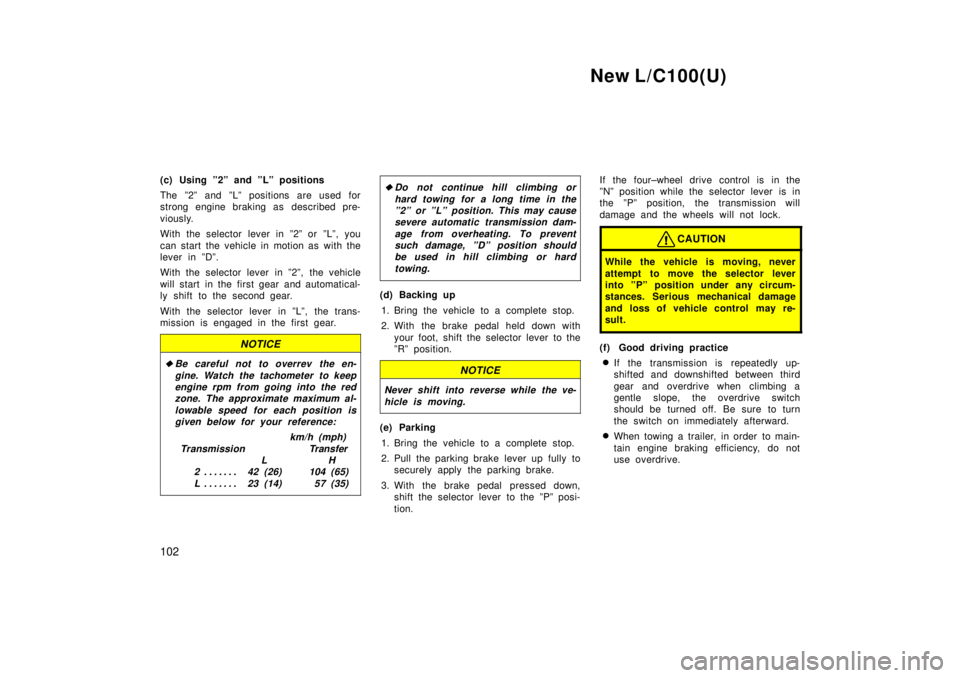
New L/C100(U)
102
(c) Using º2º and ºLº positions
The º2º and ºLº positions are used for
strong engine braking as described pre-
viously.
With the selector lever in º2º or ºLº, you
can start the vehicle in motion as with the
lever in ºDº.
With the selector lever in º2º, the vehicle
will start in the first gear and automatical-
ly shift to the second gear.
With the selector lever in ºLº, the trans-
mission is engaged in the first gear.
NOTICE
�Be careful not to overrev the en-
gine. Watch the tachometer to keepengine rpm from going into the red zone. The approximate maximum al-
lowable speed for each position isgiven below for your reference:
km/h (mph)
Transmission Transfer L H
2 42 (26) 104 (65) . . . . . . .
L 23 (14) 57 (35) . . . . . . .
�Do not continue hill climbing or
hard towing for a long time in theº2º or ºLº position. This may causesevere automatic transmission dam-
age from overheating. To preventsuch damage, ºDº position shouldbe used in hill climbing or hard
towing.
(d) Backing up
1. Bring the vehicle to a complete stop.
2. With the brake pedal held down with your foot, shift the selector lever to the
ºRº position.
NOTICE
Never shift into reverse while the ve-
hicle is moving.
(e) Parking
1. Bring the vehicle to a complete stop.
2. Pull the parking brake lever up fully to securely apply the parking brake.
3. With the brake pedal pressed down, shift the selector lever to the ºPº posi-
tion. If the four±wheel drive control is in the
ºNº position while the selector lever is in
the ºPº position, the transmission will
damage and the wheels will not lock.
CAUTION
While the vehicle is moving, never
attempt to move the selector lever
into ºPº position under any circum-
stances. Serious mechanical damage
and loss of vehicle control may re-
sult.
(f) Good driving practice
� If the transmission is repeatedly up-
shifted and downshifted between third
gear and overdrive when climbing a
gentle slope, the overdrive switch
should be turned off. Be sure to turn
the switch on immediately afterward.
� When towing a trailer, in order to main-
tain engine braking efficiency, do not
use overdrive.
Page 95 of 202
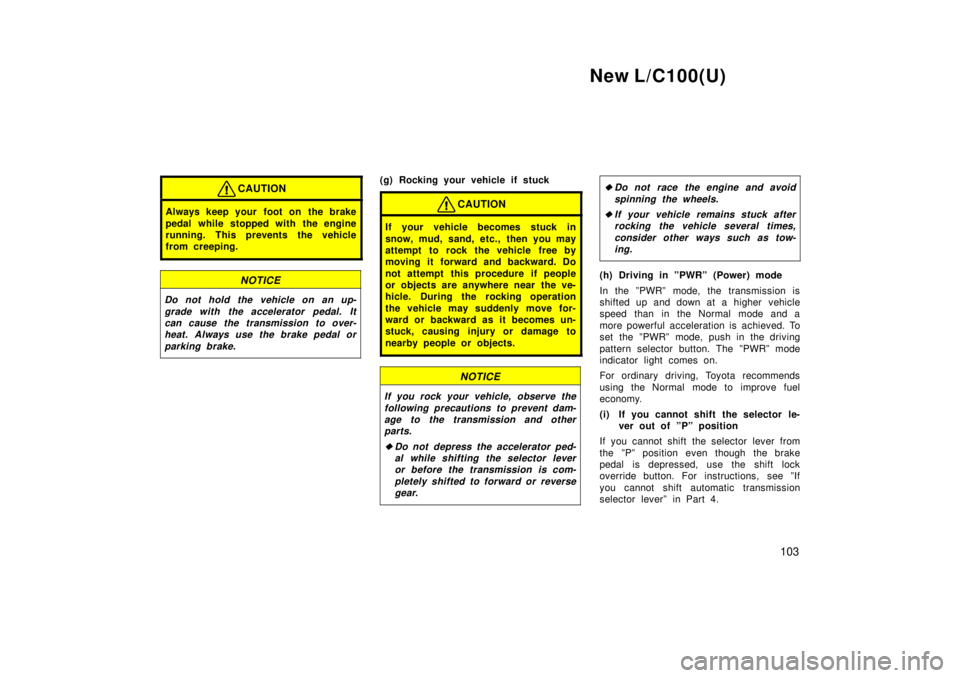
New L/C100(U)103
CAUTION
Always keep your foot on the brake
pedal while stopped with the engine
running. This prevents the vehicle
from creeping.
NOTICE
Do not hold the vehicle on an up-grade with the accelerator pedal. Itcan cause the transmission to over-heat. Always use the brake pedal or
parking brake.
(g) Rocking your vehicle if stuck
CAUTION
If your vehicle becomes stuck in
snow, mud, sand, etc., then you may
attempt to rock the vehicle free by
moving it forward and backward. Do
not attempt this procedure if people
or objects are anywhere near the ve-
hicle. During the rocking operation
the vehicle may suddenly move for-
ward or backward as it becomes un-
stuck, causing injury or damage to
nearby people or objects.
NOTICE
If you rock your vehicle, observe thefollowing precautions to prevent dam-age to the transmission and other parts.
�Do not depress the accelerator ped-
al while shifting the selector leveror before the transmission is com-
pletely shifted to forward or reversegear.
�Do not race the engine and avoid
spinning the wheels.
�If your vehicle remains stuck afterrocking the vehicle several times,
consider other ways such as tow-ing.
(h) Driving in ºPWRº (Power) mode
In the ºPWRº mode, the transmission is
shifted up and down at a higher vehicle
speed than in the Normal mode and a
more powerful acceleration is achieved. To
set the ºPWRº mode, push in the driving
pattern selector button. The ºPWRº mode
indicator light comes on.
For ordinary driving, Toyota recommends
using the Normal mode to improve fuel
economy.
(i) If you cannot shift the selector le- ver out of ºPº position
If you cannot shift the selector lever from
the ºPº position even though the brake
pedal is depressed, use the shift lock
override button. For instructions, see ºIf
you cannot shift automatic transmission
selector leverº in Part 4.
Page 98 of 202
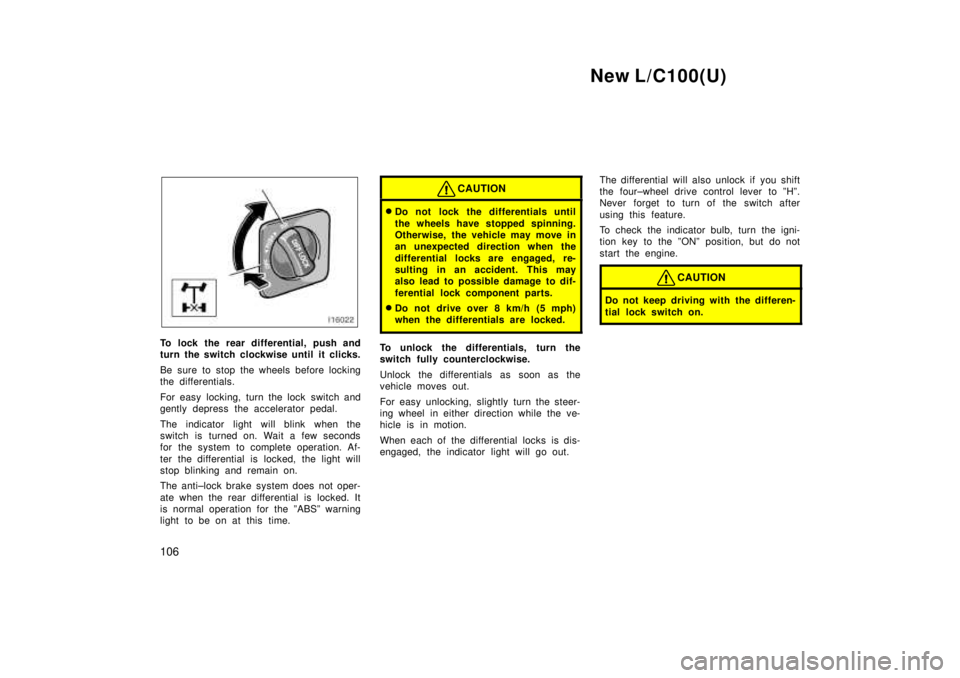
New L/C100(U)
106
To lock the rear differential, push and
turn the switch clockwise until it clicks.
Be sure to stop the wheels before locking
the differentials.
For easy locking, turn the lock switch and
gently depress the accelerator pedal.
The indicator light will blink when the
switch is turned on. Wait a few seconds
for the system to complete operation. Af-
ter the differential is locked, the light will
stop blinking and remain on.
The anti±lock brake system does not oper-
ate when the rear differential is locked. It
is normal operation for the ºABSº warning
light to be on at this time.
CAUTION
� Do not lock the differentials until
the wheels have stopped spinning.
Otherwise, the vehicle may move in
an unexpected direction when the
differential locks are engaged, re-
sulting in an accident. This may
also lead to possible damage to dif-
ferential lock component parts.
� Do not drive over 8 km/h (5 mph)
when the differentials are locked.
To unlock the differentials, turn the
switch fully counterclockwise.
Unlock the differentials as soon as the
vehicle moves out.
For easy unlocking, slightly turn the steer-
ing wheel in either direction while the ve-
hicle is in motion.
When each of the differential locks is dis-
engaged, the indicator light will go out. The differential will also unlock if you shift
the four±wheel drive control lever to ºHº.
Never forget to turn of the switch after
using this feature.
To check the indicator bulb, turn the igni-
tion key to the ºONº position, but do not
start the engine.
CAUTION
Do not keep driving with the differen-
tial lock switch on.
Page 99 of 202
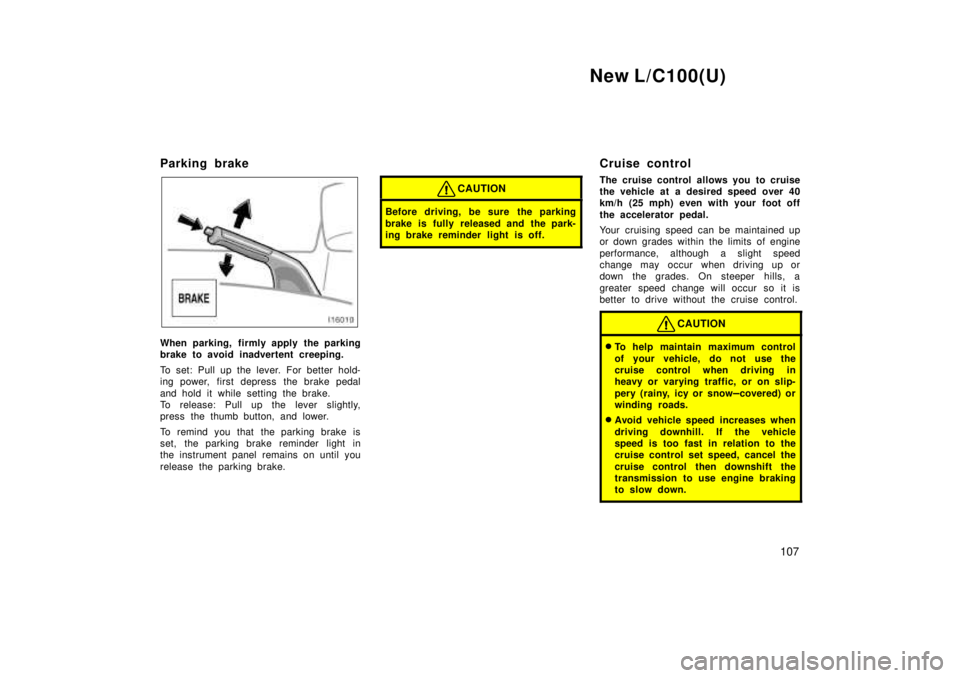
New L/C100(U)107
Parking brake
When parking, firmly apply the parking
brake to avoid inadvertent creeping.
To set: Pull up the lever. For better hold-
ing power, first depress the brake pedal
and hold it while setting the brake.
To release: Pull up the lever slightly,
press the thumb button, and lower.
To remind you that the parking brake is
set, the parking brake reminder light in
the instrument panel remains on until you
release the parking brake.
CAUTION
Before driving, be sure the parking
brake is fully released and the park-
ing brake reminder light is off.
Cruise control
The cruise control allows you to cruise
the vehicle at a desired speed over 40
km/h (25 mph) even with your foot off
the accelerator pedal.
Your cruising speed can be maintained up
or down grades within the limits of engine
performance, although a slight speed
change may occur when driving up or
down the grades. On steeper h
ills, a
greater speed change will occur so it is
better to drive without the cruise control.
CAUTION
� To help maintain maximum control
of your vehicle, do not use the
cruise control when driving in
heavy or varying traffic, or on slip-
pery (rainy, icy or snow ±covered) or
winding roads.
� Avoid vehicle speed increases when
driving downhill. If the vehicle
speed is too fast in relation to the
cruise control set speed, cancel the
cruise control then downshift the
transmission to use engine braking
to slow down.
Page 100 of 202
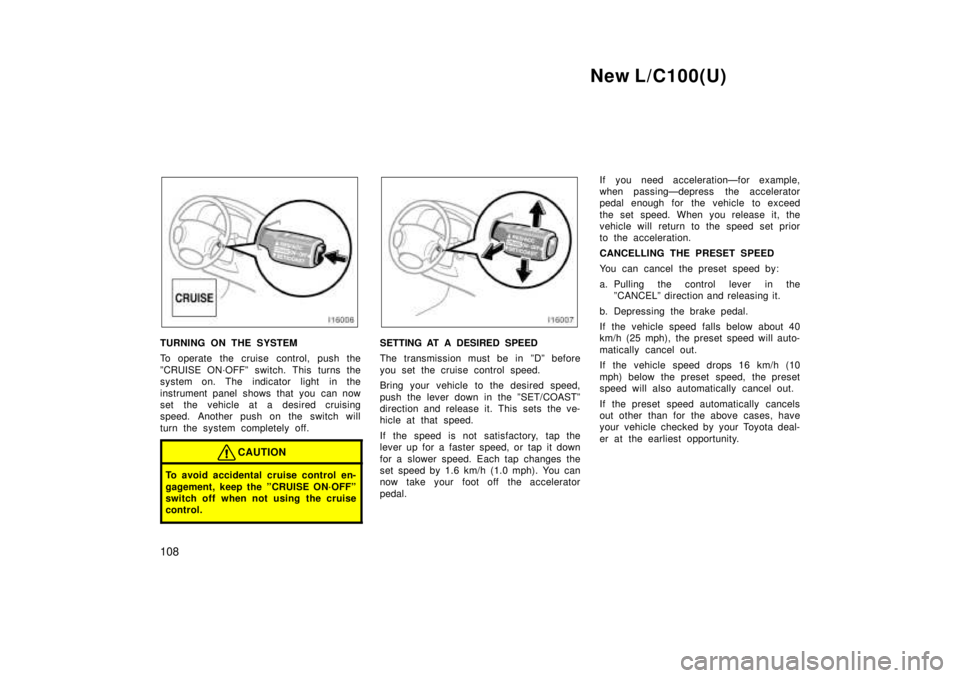
New L/C100(U)
108
TURNING ON THE SYSTEM
To operate the cruise control, push the
ºCRUISE ON´OFFº switch. This turns the
system on. The indicator light in the
instrument panel shows that you can now
set the vehicle at a desired cruising
speed. Another push on the switch will
turn the system completely off.
CAUTION
To avoid accidental cruise control en-
gagement, keep the ºCRUISE ON´OFFº
switch off when not using the cruise
control.
SETTING AT A DESIRED SPEED
The transmission must be in ºDº before
you set the cruise control speed.
Bring your vehicle to the desired speed,
push the lever down in the ºSET/COASTº
direction and release it. This sets the ve-
hicle at that speed.
If the speed is not satisfactory, tap the
lever up for a faster speed, or tap it down
for a slower speed. Each tap changes the
set speed by 1.6 km/h (1.0 mph). You can
now take your foot off the accelerator
pedal. If you need accelerationÐfor example,
when passingÐdepress the accelerator
pedal enough for the vehicle to exceed
the set speed. When you release it, the
vehicle will return to the speed set prior
to the acceleration.
CANCELLING THE PRESET SPEED
You can cancel the preset speed by:
a. Pulling the control lever in the
ºCANCELº direction and releasing it.
b. Depressing the brake pedal.
If the vehicle speed falls below about 40
km/h (25 mph), the preset speed will auto-
matically cancel out.
If the vehicle speed drops 16 km/h (10
mph) below the preset speed, the preset
speed will also automatically cancel out.
If the preset speed automatically cancels
out other than for the above cases, have
your vehicle checked by your Toyota deal-
er at the earliest opportunity.
Page 101 of 202

New L/C100(U)109
RESETTING AT A FASTER SPEED
Push the lever up in the ºRES/ACCº direc-
tion and hold it. Release the lever when
the desired speed is attained. While the
lever is held up, the vehicle will gradually
gain speed.
However, a faster way to reset is to ac-
celerate the vehicle and then push the
control lever down in the ºSET/COASTº
direction.
RESETTING AT A SLOWER SPEED
Push the lever down in the ºSET/COASTº
direction and hold it. Release the lever
when the desired speed is attained. While
the lever is held down, the vehicle speed
will gradually decrease.
However, a faster way to reset is to de-
press the brake pedal and then push the
control lever down in the ºSET/COASTº
direction.
Even if you downshift the transmission by
turning off the overdrive switch, with the
cruise control on, engine braking will not
be applied because the cruise control is
not cancelled. To decrease the vehicle
speed, reset to a slower speed with the
cruise control lever or depress the brake
pedal. If you use the brake pedal, cruise
control is cancelled.
RESUMING THE PRESET SPEED
If the preset speed is cancelled by pu
lling
the control lever or by depressing the
brake pedal or clutch pedal, pushing the
lever up in the ºRES/ACCº direction will
restore the speed set prior to cancellation.
However, once the vehicle speed falls be-
low about 40 km/h (25 mph), the preset
speed will not be resumed.
CRUISE CONTROL FAILURE WARNING
If the ºCRUISEº indicator light in the
instrument cluster flashes when using the
cruise control, press the ºCRUISE
ON´OFFº button to turn the system off and
then press it again to turn it on. If any of the following conditions then oc-
curs, there is some trouble in the cruise
control system.
� The indicator light does not come on.
� The indicator light flashes again.
� The indicator light goes out after it
comes on.
If this is the case, contact your Toyota
dealer and have your vehicle inspected.
Page 143 of 202
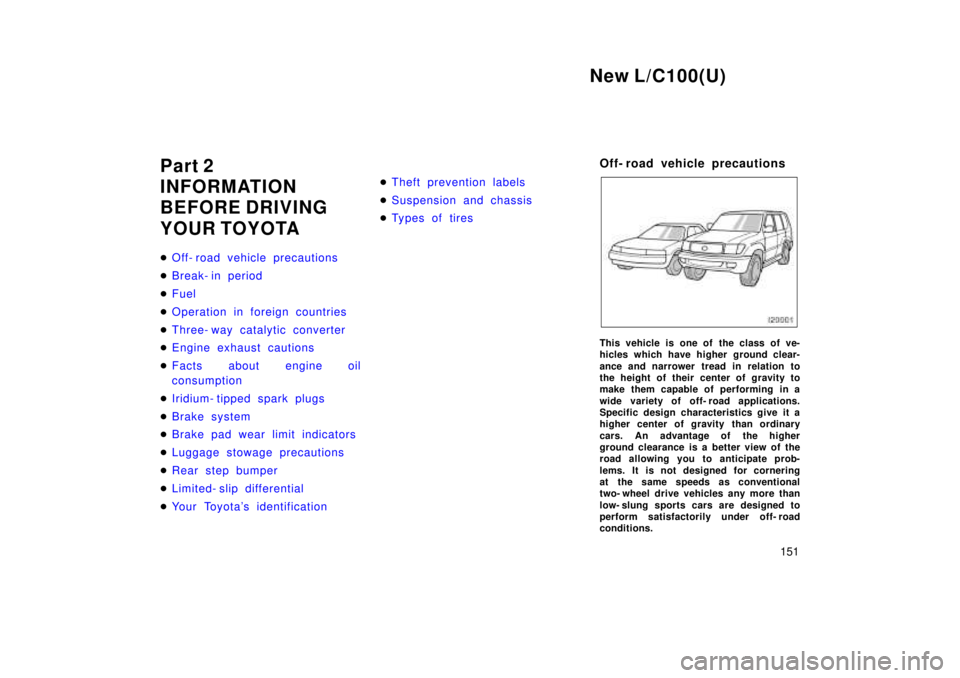
New L/C100(U)151
Part 2
INFORMATION
BEFORE DRIVING
YOUR TOYOTA �
Off- road vehicle precautions
�Break- in period
�Fuel
�Operation in foreign countries
�Three- way catalytic converter
�Engine exhaust cautions
�Facts about engine oil
consumption
�Iridium- tipped spark plugs
�Brake system
�Brake pad wear limit indicators
�Luggage stowage precautions
�Rear step bumper
�Limited- slip differential
�Your Toyota's identification
�Theft prevention labels
�Suspension and chassis
�Types of tires
Off- road vehicle precautions
This vehicle is one of the class of ve-
hicles which have higher ground clear-
ance and narrower tread in relation to
the height of their center of gravity to
make them capable of performing in a
wide variety of off- road applications.
Specific design characteristics give it a
higher center of gravity than ordinary
cars. An advantage of the higher
ground clearance is a better view of the
road allowing you to anticipate prob-
lems. It is not designed for cornering
at the same speeds as conventional
two- wheel drive vehicles any more than
low- slung sports cars are designed to
perform satisfactorily under off- road
conditions.